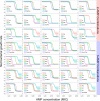Combination Effects of Antimicrobial Peptides
- PMID: 26729502
- PMCID: PMC4775937
- DOI: 10.1128/AAC.02434-15
Combination Effects of Antimicrobial Peptides
Abstract
Antimicrobial peptides (AMPs) are ancient and conserved across the tree of life. Their efficacy over evolutionary time has been largely attributed to their mechanisms of killing. Yet, the understanding of their pharmacodynamics both in vivo and in vitro is very limited. This is, however, crucial for applications of AMPs as drugs and also informs the understanding of the action of AMPs in natural immune systems. Here, we selected six different AMPs from different organisms to test their individual and combined effects in vitro. We analyzed their pharmacodynamics based on the Hill function and evaluated the interaction of combinations of two and three AMPs. Interactions of AMPs in our study were mostly synergistic, and three-AMP combinations displayed stronger synergism than two-AMP combinations. This suggests synergism to be a common phenomenon in AMP interaction. Additionally, AMPs displayed a sharp increase in killing within a narrow dose range, contrasting with those of antibiotics. We suggest that our results could lead a way toward better evaluation of AMP application in practice and shed some light on the evolutionary consequences of antimicrobial peptide interactions within the immune system of organisms.
Copyright © 2016 Yu et al.
Figures






References
-
- Greco WR, Bravo G, Parsons JC. 1995. The search for synergy: a critical review from a response surface perspective. Pharmacol Rev 47:331–385. - PubMed
Publication types
MeSH terms
Substances
LinkOut - more resources
Full Text Sources
Other Literature Sources
Medical

